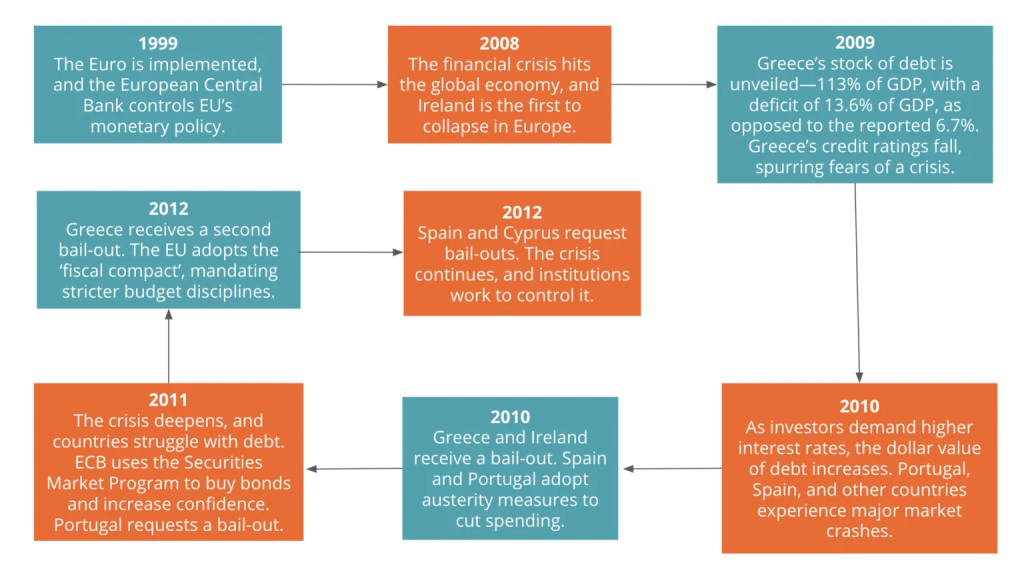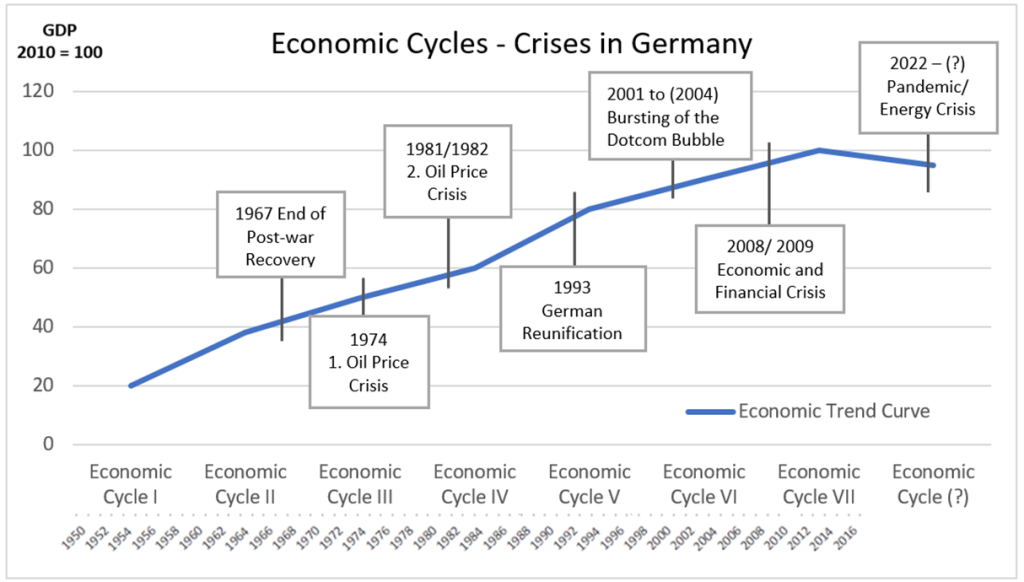Vietinis: istoriniai rinkos griūtys Europoje
Pamokos mokymosi tikslai:
- Įvadas: Understand the impact of historical market crashes in Europe, focusing on their causes, consequences, and the lessons learned. This understanding is crucial for financial professionals, investors, and policymakers.
- Recognize the systemic vulnerabilities that led to the European Sovereign Debt Crisis and how these challenges were addressed through policy changes and financial support mechanisms.
- Analyze the Black Wednesday event to comprehend the implications of currency devaluation and its effects on national economies and investor confidence.
- Learn from the Dotcom Crash to identify signs of market exuberance in tech investments and the subsequent regulatory responses to stabilize financial markets.
5.1 Historical Market Crashes in Europe
Europe has experienced several significant market crashes, each with unique causes and effects that reverberated across the continent. These events not only reshaped the economic landscape but also influenced financial regulations, investor behavior, and market dynamics in Europe.
- The European Sovereign Debt Crisis (2010–2012): One of the most critical market crashes in Europe occurred following the global financial crisis of 2008. The European debt crisis was triggered by excessive government debt in several Eurozone countries, including Greece, Portugal, Spainir Italy. Greece was particularly hard hit, requiring multiple international bailouts to stabilize its economy. This crisis led to deep recessions in these countries and created instability in the Eurozone, prompting fears of a Eurozone breakup.
The ECB stepped in with emergency measures, including lowering interest rates and providing financial aid through quantitative easing programs. The crisis also led to significant austerity measures in affected countries, which, in turn, sparked public protests and further political instability. - Black Wednesday (1992): Another notable market crash in Europe was Black Wednesday, when the UK was forced to withdraw from the European Exchange Rate Mechanism (ERM). This event caused the British pound to plummet, leading to a severe recession in the UK. The UK’s inability to maintain its currency’s peg to the Deutsche Mark led to significant losses for investors and caused interest rates to soar temporarily, leading to widespread financial difficulties for businesses and homeowners.
- Dotcom Crash (2000): Although often seen as a U.S.-centric event, the Dotcom Crash also had severe consequences for European markets. Many European technology companies saw their stock prices skyrocket in the late 1990s, only to crash dramatically in 2000. This market collapse disproportionately affected the German Neuer Markt, which was modeled on the NASDAQ and listed high-tech startups. Following the crash, the Neuer Markt lost most of its value and was eventually closed.
The aftermath of these crashes led to tighter financial regulations across Europe, such as MiFID (Markets in Financial Instruments Directive), which was introduced to improve investor protection and market transparency.

Paveikslėlis: European Sovereign Debt Crisis Timeline
Aprašymas:
The figure outlines the timeline of the European Sovereign Debt Crisis, beginning with the implementation of the Euro in 1999, followed by key events like the 2008 financial crisis, Greece’s debt revelation in 2009, and subsequent bailouts of Greece, Ireland, Spain, Cyprus, and Portugal between 2010 and 2012. The figure highlights the progression of the crisis, including the implementation of austerity measures and stricter fiscal policies by affected countries to restore confidence.
Svarbiausios išvados:
- Greece’s debt crisis triggered broader instability in the Eurozone.
- Ireland, Spain, Portugal, and Cyprus faced major economic challenges and required bailouts.
- The fiscal compact was adopted to enforce stricter budgetary discipline in the EU.
- Market confidence wavered, causing spikes in borrowing costs and major economic disruptions.
Informacijos taikymas:
This timeline helps users understand the causes and responses to the European Sovereign Debt Crisis. Investors can apply this information to analyze how sovereign debt crises impact economies, financial markets, and monetary policy decisions. It underscores the importance of fiscal discipline and the need for timely intervention during economic downturns.
5.2 Four Historical Business Cycles
- Post-War Reconstruction (1945–1950s): After World War II, Europe entered a period of rapid economic expansion known as the Post-War Boom arba Wirtschaftswunder (economic miracle) in countries like Germany and Italy. This business cycle was characterized by strong industrial growth, massive infrastructure projects, and significant economic aid through programs like the Marshall Plan. The expansion was fueled by the rebuilding of war-torn economies and technological advancements. Key industries like manufacturing, steel, and automobile production boomed, particularly in Germany, leading to increased employment and higher standards of living across Western Europe.
- Plėtros etapas: The economies of Western Europe grew rapidly, with GDP and industrial production rising sharply.
- Peak Phase: By the late 1950s, European economies had reached their post-war peaks, with high employment rates and robust industrial output.
- Contraction Phase: The early 1960s saw a slowdown as inflation began to rise, and the post-war recovery effects wore off, leading to a minor recession in some countries.
- Trough Phase: The trough in this cycle was mild, with the economy rebounding relatively quickly thanks to strong global demand for European goods.
- European Stagflation (1970s): The 1970s oil crises and the collapse of the Bretton Woods system led to a period of stagflation (high inflation combined with stagnant economic growth) across Europe. The sharp rise in oil prices in 1973 and again in 1979 caused production costs to spike, leading to widespread economic slowdown and inflation in many European countries. The resulting economic stagnation, particularly in the UK, France, and Italy, caused unemployment to rise while inflation remained high.
- Plėtros etapas: Leading up to the oil shocks, European economies were growing steadily, particularly in the early 1970s, due to high consumer demand and post-war rebuilding.
- Peak Phase: The oil price spike and energy crisis caused inflation to surge, marking the peak of economic activity.
- Contraction Phase: The sudden increase in costs for oil-dependent industries led to economic contraction across Europe. High inflation and unemployment characterized this period.
- Trough Phase: Recovery was slow, as European governments struggled to balance inflationary pressures with efforts to stimulate economic growth. Structural reforms and monetary policies began stabilizing economies in the 1980s.
- Eurozone Debt Crisis (2010–2012): Following the 2008 global financial crisis, several Eurozone countries, notably Greece, Portugal, Ireland, and Spain, faced sovereign debt crises. These countries had accumulated high levels of public debt, and as investor confidence faltered, borrowing costs soared. The crisis exposed weaknesses in the Eurozone’s fiscal integration, leading to harsh austerity measures and a deep recession across Southern Europe.
- Plėtros etapas: Prior to the 2008 crisis, many Eurozone countries enjoyed a period of growth fueled by easy access to credit, low interest rates, and a real estate boom, particularly in Spain and Ireland.
- Peak Phase: The global financial crisis and subsequent recession in 2008–2009 brought an abrupt end to this expansion, but the effects of the crisis didn’t immediately manifest in the Eurozone.
- Contraction Phase: By 2010, sovereign debt concerns in Greece, Portugal, and Spain led to severe economic contractions. Austerity measures imposed by international lenders led to reduced public spending and widespread unemployment.
- Trough Phase: The trough occurred in the early 2010s, with countries like Greece and Spain facing unemployment rates exceeding 20%. Recovery began slowly as the ECB intervened with quantitative easing programs and low interest rates to stabilize the Eurozone economy.
- COVID-19 Pandemic (2020–Present): The COVID-19 pandemic caused one of the deepest recessions in European history. The sudden lockdowns and global travel restrictions led to a sharp contraction in consumer spending, production, and international trade. European governments implemented large-scale fiscal stimulus packages and the ECB responded with aggressive monetary policies, including near-zero interest rates and asset purchase programs, to support economic recovery.
- Plėtros etapas: Prior to the pandemic, Europe was experiencing slow but steady growth, with low inflation and low unemployment in countries like Germany and France.
- Peak Phase: The peak occurred in early 2020, just before the pandemic hit. The rapid spread of COVID-19 caused economic activity to come to a standstill as countries imposed strict lockdowns.
- Contraction Phase: The contraction was severe, with a sharp decline in GDP across Europe, particularly in sectors like tourism, hospitality, and manufacturing. Unemployment surged, especially in countries reliant on tourism, like Spain and Italy.
- Trough Phase: Recovery is ongoing as of 2023, with European economies rebounding at different rates. Governments and central banks continue to support recovery efforts through fiscal stimulus and monetary easing.

Paveikslėlis: Economic Cycles – Crises in Germany
Aprašymas:
This figure shows the economic trend curve for Germany, highlighting key crises and events from 1950 to 2022. It depicts Germany’s economic growth and downturns, represented by GDP indexed to 2010 levels. The figure identifies major events like the end of post-war recovery (1967), oil price crises (1974, 1981/82), German reunification (1993), the dotcom bubble (2001-2004), the 2008/2009 financial crisis, and the 2022 pandemic/energy crisis, indicating their impacts on economic cycles.
Svarbiausios išvados:
- Economic cycles reflect Germany’s economic resilience and vulnerabilities over time.
- Major events like oil price crises, financial crisesir reunification impacted GDP growth trends.
- The 2022 energy crisis suggests a potential downturn, indicating ongoing economic challenges.
- Understanding past crises helps to anticipate potential impacts of future economic cycles on GDP.
Informacijos taikymas:
This data aids users in understanding the cyclic nature of economies, emphasizing the significance of historical events in shaping GDP trends. Investors can use this information to evaluate economic resilience and to strategize around potential downturns during periods of uncertainty, enhancing their ability to anticipate market movements during different economic cycles.
Pagrindinė pamokos informacija:
- European Sovereign Debt Crisis: Highlighted the interconnectedness of Eurozone economies and led to significant financial reforms such as stricter fiscal rules and enhanced roles for continental financial institutions like the ECB.
- Black Wednesday: Demonstrated the vulnerability of fixed exchange rate systems and influenced the UK’s approach to monetary policy and its decision to keep the pound sterling outside the eurozone.
- Dotcom Crash: Served as a critical lesson on the volatility of tech markets and prompted a reevaluation of investment strategies and market valuation methods, influencing both European and global technology sectors.
- Regulatory Impact: Each of these crashes led to increased financial regulation, such as the Markets in Financial Instruments Directive (MiFID), aimed at improving transparency, protecting investors, and stabilizing markets.
Baigiamasis pareiškimas
By studying these historical market crashes, stakeholders can better prepare for future financial downturns, enhance regulatory frameworks, and develop more resilient economic systems. This knowledge is invaluable for reducing the adverse impacts of similar events and fostering a more stable and secure financial environment in Europe.

